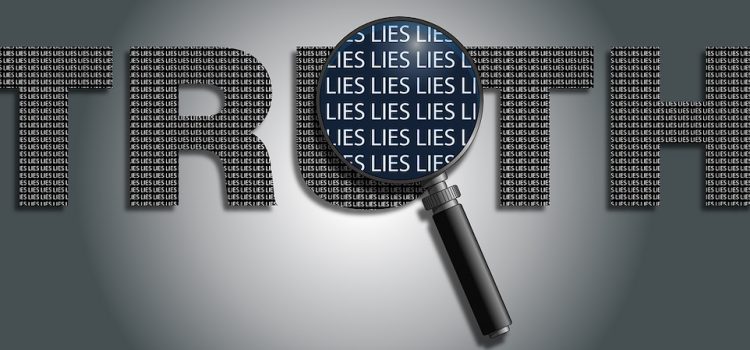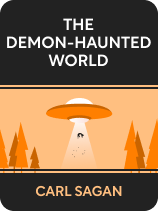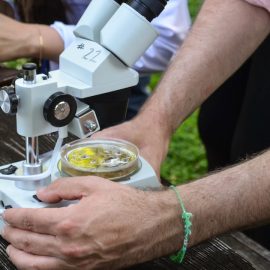

This article is an excerpt from the Shortform book guide to "The Demon-Haunted World" by Carl Sagan. Shortform has the world's best summaries and analyses of books you should be reading.
Like this article? Sign up for a free trial here .
What’s Carl Sagan’s baloney detection kit? How can you use it to get at the truth about science and everything else?
Scientists are trained with what Carl Sagan calls a “baloney detection kit.” They’re given tools for critical thinking and healthy skepticism that help them cut through the fog in the pursuit of truth. Sagan argues that we all need this kit, whether we’re trying to figure out the truth about the moon landing or an ad’s claim about toothpaste. In The Demon-Haunted World, Sagan explains how commercial culture tends to discourage critical thinking, shares three questions that foster healthy skepticism, describes common fallacies, and identifies five fallacious anti-science arguments.
Keep reading to learn more about Carl Sagan’s baloney detection kit and how it can help you know what’s true and what isn’t.
Sagan’s Baloney Detection Kit
Carl Sagan says the pervasive commercialism of our modern world and our seemingly unlimited access to information make it much harder to determine what’s true and what’s not. Let’s explore why we’re often taken in by false advertising and then take a look at Carl Sagan’s baloney detection kit, which provides tools to help you evaluate the veracity of a claim.
How Commercial Culture Discourages Critical Thinking
Sagan claims that commercial culture erodes our critical faculties in order to make money. Skepticism, he says, doesn’t sell. Exaggerated headlines and pseudosciences appeal to our emotions, engender more attention, and thus, generate more profits. For this reason, we’re likely to encounter many false or misleading claims through various media (television, radio, newspapers, and online sources): We’re constantly encouraged to buy things without thinking too much about what we’re buying or if the claims about the efficacy of the product are even valid. According to Sagan, even “real scientists” promote products for personal gain at the expense of the consumer and science alike. Commercial culture cultivates a general sense of credulity amongst the population, which is then used to feed you more baloney and extract more of your money.
| Deceptive Advertising Sagan was particularly prescient in his discussion of commercial culture. In 2022, deceptive or misleading claims in advertisements are still common. Here are some deceptive ad trends experts are worried about in 2022: Amazon’s liability: A large part of Amazon’s business is marketing and selling third-party products on its platform. Many have filed lawsuits trying to hold Amazon accountable for misleading customers or selling fake products, but these issues still remain. Life-saving claims: The criteria used for what is considered “life-saving” may differ from one company to the next. For example, Life Alert appears to have a very loose definition of “life-saving” to make it look like it saves more lives than it actually does. Income claims: As the multi-level marketing (MLM) industry grows, so do claims that people can make a lot of money by joining an MLM. These claims are usually false or exaggerated, as the vast majority of people joining MLMs make little or no money. Dark patterns: Dark patterns include things like tricking customers into signing up for subscriptions, claiming a product is in limited supply when it isn’t, or “confirmshaming,” in which customers are guilted into making purchases. |
Tools for Skeptical Thinking
Sagan argues that skeptical thinking is more important in the modern world than ever before. The processes of science have a toolkit for skeptical thinking built in, one which the general public may not use or even be aware of. Essentially, skeptical thinking is a method of creating and understanding a well-founded argument. Sagan recommends asking some questions aimed at fostering skepticism:
- Can a study be validated by other sources? Research that isn’t validated by outside sources is much more likely to be biased, fabricated, or irreproducible. A strong hypothesis will get the same results study after study. This is why reputable science journals only publish peer-reviewed research.
- Is the argument based on evidence or an authority? There are experts in science, not authorities. An argument from an authoritative figure does not carry any more weight. The validity of a claim depends entirely on the evidence, not the person or group providing it.
- Can a hypothesis be disproved? If a claim can’t be disproven, it can’t be proven, because there is no real way to test the hypothesis. Unfalsifiable hypotheses are a common tactic of pseudosciences. They shield themselves from criticism by making assertions that others can’t disprove.
| How to Be a “True” Skeptic Skepticism is a major principle of the scientific method, but it can be used incorrectly. Experts note that the language of skepticism has been co-opted to lend credence to pseudosciences and conspiracy theories. Anti-vaxxers or climate change deniers may tell you to “do your own research” instead of going along with conventional wisdom. There are many “skeptics” like this, and most of them are motivated by a desire for the truth, but there is real danger when claims that vaccines cause autism are treated as seriously as the science behind the vaccines. This brand of skepticism seems to be more about discrediting established science or questioning objective truth in general than about making a valid argument against it. Scientific skepticism is open to criticism. It challenges widely accepted beliefs, but it does so while adhering to evidence. It is not enough to simply be skeptical—you must be willing to support your claims, not just question everything and attack all other claims to knowledge. Therefore, while the above skeptical questions Sagan provides are a good start, it’s important to also take into account the credibility of any alternative sources of information you look to—for example, independent validation of a hypothesis should come from a credible source. |
Common Fallacies
Sagan claims it’s just as important to understand deceptive or fallacious arguments as it is to understand a reasonable argument. There is a long list of logical and rhetorical fallacies, and many of them are commonly seen in religious and political discourse. They’re also frequently used to criticize science. Here are a few of the most common examples.
- Non sequitur: When the conclusion doesn’t logically follow from the premise of the argument. Many of the logical fallacies mentioned can be considered nonsequiturs.
- Ad hominem: Attacking the person making the argument rather than the argument itself. Essentially, this is resorting to name-calling instead of making an actual counterargument.
- Appeal to authority: When an opinion from an authority is used to support an argument
- False dichotomy: To only consider the two extreme sides of an argument when there are many more options
- Straw man: To distort or exaggerate an opposing argument to make it easier to attack
| Fallacious Anti-Science Arguments Sagan provides common examples of rhetorical fallacies. It is important to understand how they work for any argument, but with climate change denial growing, understanding in particular how they’re used to criticize science is crucial. Scientists found common rhetorical techniques used for science denial across a range of topics including climate change and evolution. There are five common techniques of science denial. Fake experts: When an unqualified person or institution is presented as a source of credible information. This can be seen as an extension of the appeal to authority. It is not the person’s credentials that matter, but their argument. An example might be: “A retired physicist argues that the current weather change is completely natural.” Logical fallacies: Also known as nonsequiturs. There are many logical fallacies used to deny science. Here are examples: “Climate science can’t be trusted because climate scientists are biased.” (Ad hominem) “Climate has changed naturally in the past, so current climate change must also be natural.” (False dichotomy) “In the 1970s, climate scientists predicted there would be an ice age.” (Straw man) Impossible expectations: Demanding unrealistic standards of certainty before acting on the science. For example, “Scientists don’t know what the climate will be like decades from now.” Cherry picking: Selecting data that supports your argument while ignoring data that contradicts it. For instance, “There are record low temperatures today—whatever happened to global warming?” Conspiracy theories: In regard to science denial, this often involves some secret plan to hide the truth for nefarious reasons. An example could be: “The temperature record is fabricated by scientists to push a socialist agenda.” |
Exercise: Examine Your Beliefs and Claims to Knowledge
Sagan argues that we often are resistant to new discoveries because they challenge our existing beliefs. Here, examine your beliefs and think about how they might affect your openness to new information.
- Think about your core beliefs. Pick something you believe in that doesn’t have enough scientific backing to be considered fact. This could be a religious or spiritual belief or simply an opinion you have that shapes the way you view the world. Why do you think you hold this belief?
- How does this belief affect your life and the decisions you make, large or small?
- What would it take for you to dismiss this belief or believe in something else? Are you more likely to investigate new information if it upholds your beliefs or if it opposes them? Why do you think that is?

———End of Preview———
Like what you just read? Read the rest of the world's best book summary and analysis of Carl Sagan's "The Demon-Haunted World" at Shortform .
Here's what you'll find in our full The Demon-Haunted World summary :
- Carl Sagan’s argument that a less scientifically-minded society is a less prosperous one
- Why you must remain critical and well-informed in an increasingly complex world
- The decline of educational standards in America and possible ways to reverse it






